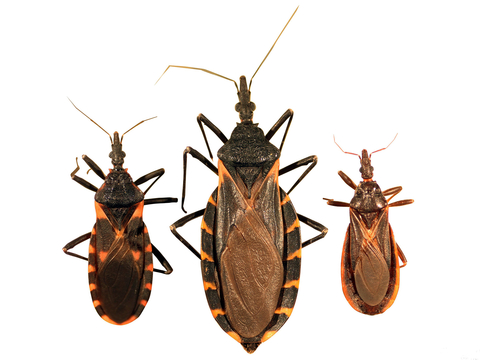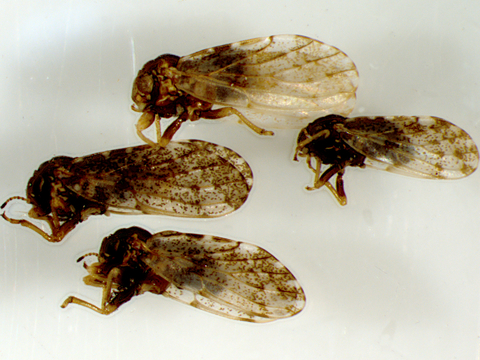Quick facts
- Western conifer seed bugs and hackberry psyllids are nuisance invaders in homes and other buildings.
- Western conifer seed bugs can be confused with kissing bugs, which do not occur in Minnesota.
- Physical removal is the best control for these insects.
- Pesticides are usually not necessary to control them.
Western conifer seed bug and hackberry psyllids are:
- Harmless to property and are just nuisances.
- They are attracted to the sunny sides of buildings and enter through cracks and spaces around windows, doors, siding and other sites.
- Neither can reproduce indoors.
- When these insects are found inside during winter or spring, it is because they entered the building the previous fall.
Western conifer seed bug
Leptoglossus occidentalis is a type of leaf-footed bug.
- It is about 3/4 inch long, elongate and fairly robust.
- It is reddish-brown with a white zig-zag line across the center of its wings.
- It has long, conspicuous back legs with leaf-like structures on them.
- When this insect flies, it can buzz, sounding like a bumble bee. It also exposes orange and black stripes on its abdomen.
This insect can be mistaken for a cockroach because of its similar size, color and noticeable antennae.
- However, a cockroach moves quickly, does not fly, hides during the day, and has antennae as long or longer than its body.
- A western conifer seed bug moves slowly, flies, is commonly seen during the day, and has antennae that extend less than half the length of its body.
Biology
Nymphs and adults spend the summer on pines and Douglas firs, feeding on sap from green cones and needles.
- This feeding does not harm landscape trees in the Midwest.
- As the weather cools in September, western conifer seed bug adults search for sheltered places to spend the winter.
- These bugs rarely accumulate in large numbers like boxelder bugs or lady beetles and typically just one or a few are seen at a time.
- It is common to see them indoors during mild winter days and early spring.
Importance
- These insects are found in small numbers in homes during fall, winter and spring.
- They don’t bite or sting and are harmless to people.
They are sometimes confused with kissing bugs because of their similar color, size and general shape.
Kissing bugs are distinguished by:
- A more pear-shaped body with a thinner head and thinner antennae, but a wider abdomen.
- Their legs are thin, without any leaf-like structures.
- They have light and dark banding along the edges of the abdomen that are visible from above.
Kissing bugs do not occur in Minnesota or anywhere in the upper Midwest.
- They feed on the blood of vertebrate animals, including humans.
- They are potential carriers of Chagas disease. To learn more, visit the Centers for Disease Control and Prevention (CDC).
Hackberry psyllids (SILL-ids)
Pachypsylla celtidivesicula and P. celtidismamma appear gnat-like. When examined closely, a psyllid resembles a miniature cicada.
- Hackberry psyllids are 1/8 to 3/16 inch long.
- They have mottled brownish wings with small black and white spots.
- Their wings extend past the abdomen and are held tent-like over their body.
- They are also known as jumping plant lice and can jump and fly away quickly.
Biology
Adult psyllids emerge from their overwintering sites in early spring and fly to hackberry trees to lay eggs in developing leaves.
- Eggs hatch into tiny nymphs that feed on the leaves.
- This feeding causes the leaves to form abnormal plant tissue (galls) surrounding individual psyllids.
- The psyllids live and feed inside these galls for the rest of the summer.
Psyllids complete their development in late summer and adults exit the galls to spend the winter in protected sites, such as cracks and crevices of tree bark and other sheltered locations, including buildings.
Importance
Hackberry psyllids cause plant galls commonly seen on hackberry leaves. These insects only produce galls in hackberry trees. Galls can affect the appearance of leaves but do not harm a healthy, mature tree even when large numbers are present.
- Pachypsylla celtidivesicula is responsible for hackberry blister galls on the upper surface of leaves.
- P. celtidismamma produce hackberry nipple galls on the underside of leaves.
Psyllids sometimes may prick the exposed skin of people as they ‘taste test’ us looking for food. These “bites” are annoying but nothing more. Otherwise, psyllids are harmless to people, pets and property.
- They are small enough to pass through most screens and are especially common around windows.
- Small to moderate numbers of psyllids may be seen, although the numbers vary from year to year.
How to get rid of these insects
Keep them out by pest-proofing building exteriors
- Seal cracks and spaces around doors, windows, fascia boards and similar places, and where utility wires and pipes enter buildings.
- Install storm windows and 18 mesh size screens to keep out psyllids.
- Repair or replace damaged window and door screens along with any damaged screens in roof and soffit vents, or bathroom and kitchen fans.
- Install door sweeps or thresholds to all exterior entry doors. Install a rubber seal along the bottom of garage doors.
- Psyllids are attracted to lights at night. Keep outside lighting turned off or install lights, such as yellow lights, that are less attractive to insects.
Physically remove any insects found inside
When these insects are found indoors, remove them by physical means, such as by hand with a tissue or a vacuum.
If there is a hackberry tree in your yard
It is not recommended to cut down hackberry trees in your yard to prevent psyllid problems.
- Mature, healthy trees are very valuable in the landscape.
- Cutting a tree down in the yard does not guarantee you will not have psyllids; they can still come to your home from nearby hackberry trees in the neighborhood.
It is possible to treat your trees before galls are produced in the spring but this is not encouraged. The timing is challenging and the management of galls is difficult and not practical.
- Because of extended egg-laying, several applications of residual insecticides are necessary.
- Often the trees are large which makes coverage difficult.
- As stated above, even if hackberry is successfully treated to prevent galls, psyllids can still fly onto your property from the surrounding neighborhood.
- Treatments applied in the summer and fall are not effective.
Using pesticides
Treating the outside of a home with an insecticide to prevent these insects from entering buildings is not practical and not necessary. Only a small number of insects typically come and in and the chances of keeping them out are small.
An exception to this could be if high numbers of hackberry psyllids are entering buildings in the fall. An application of a residual insecticide, such as permethrin, ß-cyfluthrin, or deltamethrin can help keep them out. Spray especially around windows and doors.
Pesticides are not necessary to treat these insects when found indoors. Physical removal is the only necessary control.
CAUTION: Mention of a pesticide or use of a pesticide label is for educational purposes only. Always follow the pesticide label directions attached to the pesticide container you are using. Be sure that the area you wish to treat is listed on the label of the pesticide you intend to use. Remember, the label is the law.
Reviewed in 2024



